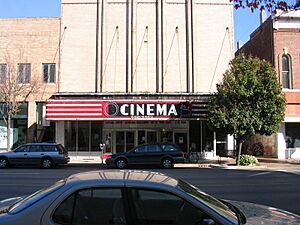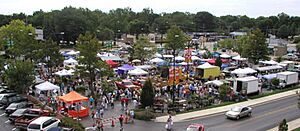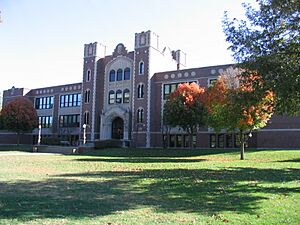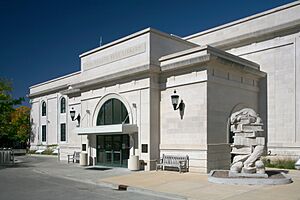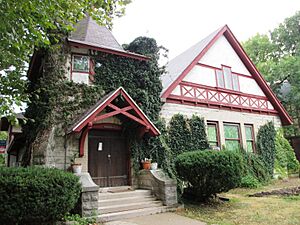Urbana, Illinois facts for kids
Quick facts for kids
Urbana, Illinois
|
||
|---|---|---|
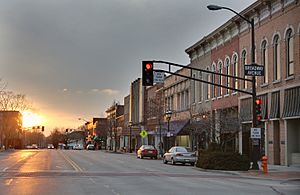
Downtown Urbana
|
||
|
||

Location of Urbana in Champaign County, Illinois.
|
||
| Country | United States | |
| State | Illinois | |
| County | Champaign | |
| Founded | 1833 | |
| Named for | Urbana, Ohio, US | |
| Government | ||
| • Type | Mayor–council | |
| Area | ||
| • City | 11.90 sq mi (30.83 km2) | |
| • Land | 11.83 sq mi (30.64 km2) | |
| • Water | 0.07 sq mi (0.19 km2) | |
| Elevation | 732 ft (223 m) | |
| Population
(2020)
|
||
| • City | 38,336 | |
| • Density | 3,240.57/sq mi (1,251.15/km2) | |
| • Metro | 236,072 | |
| Time zone | UTC−6 (CST) | |
| • Summer (DST) | UTC−5 (CDT) | |
| Postal code |
61801–61803
|
|
| Area codes | 217, 447 | |
| FIPS code | 17-77005 | |
| GNIS ID | 2397097 | |
Urbana (/ɜːrˈbænə/ ur-BAN-ə) is a city in Champaign County, Illinois, United States. It is the county seat, which means it's where the county government is located. In 2020, Urbana had about 38,336 people living there. It's a main city in the larger Champaign–Urbana metropolitan area, which had 236,000 residents in 2020.
Urbana is famous for sharing the main campus of the University of Illinois with its nearby city, Champaign. These two cities are often called "Urbana-Champaign" or "Champaign-Urbana."
Contents
History of Urbana
The area where Urbana is now was first settled by Europeans in 1822. Back then, it was known as "Big Grove." In 1833, when Champaign County was officially created, Urbana was chosen as the county seat. William T. Webber and M. W. Busey, who is considered the city's founder, donated land for the new town.
The name "Urbana" came from Urbana, Ohio. This was the hometown of State Senator John W. Vance, who helped create Champaign County. The new town was celebrated for the first time on July 4, 1833.
Early Growth and Challenges
Stores started opening in Urbana in 1834. The first mills, which processed grain, were built around 1838-1850. The city's first church, the Methodist Episcopal Church, was built in 1840. The Baptist Church followed in 1855, and the Presbyterian Church in 1856. Urbana's first school was built in 1854.
Urbana faced a challenge when the Chicago branch of the Illinois Central Railroad was built. Everyone expected it to pass through Urbana. However, the railroad was built two miles west instead, where the land was flatter. A new town called West Urbana grew up around the train station built there in 1854. In 1861, West Urbana changed its name to Champaign.
This competition between Urbana and Champaign led Urbana to build a much bigger and fancier County Courthouse. This was to make sure that Urbana remained the county seat.
University of Illinois Opens
Thanks to the efforts of Clark Griggs, Champaign-Urbana was chosen for a new state agricultural school. This school, called Illinois Industrial University, opened in 1868 with 77 students. It later became the University of Illinois Urbana-Champaign.
Over the years, there have been several attempts to combine Urbana and Champaign into one city. However, these ideas have always been voted down by the people.
Great Fire of 1871
On October 9, 1871, a large fire burned much of downtown Urbana. The fire started when children were playing with matches. This fire happened during a very dry period and was spread by strong winds. It was not connected to the Great Chicago Fire, which started the day before.
Geography of Urbana
Urbana covers about 11.90 square miles (30.83 square kilometers). Most of this area, about 11.83 square miles (30.64 square kilometers), is land. The rest is water.
Urbana is right next to the city of Champaign. The main campus of the University of Illinois Urbana-Champaign is located on the border between the two cities. Together, these cities are often called Urbana-Champaign or Champaign-Urbana. With the nearby village of Savoy, they form the larger Champaign–Urbana metropolitan area.
| Climate data for Urbana, Illinois (1981–2010 normals) | |||||||||||||
|---|---|---|---|---|---|---|---|---|---|---|---|---|---|
| Month | Jan | Feb | Mar | Apr | May | Jun | Jul | Aug | Sep | Oct | Nov | Dec | Year |
| Record high °F (°C) | 70 (21) |
72 (22) |
85 (29) |
95 (35) |
97 (36) |
103 (39) |
109 (43) |
102 (39) |
102 (39) |
93 (34) |
80 (27) |
71 (22) |
109 (43) |
| Mean daily maximum °F (°C) | 32.9 (0.5) |
37.7 (3.2) |
49.9 (9.9) |
62.8 (17.1) |
73.4 (23.0) |
82.5 (28.1) |
85.0 (29.4) |
83.7 (28.7) |
78.2 (25.7) |
65.2 (18.4) |
50.6 (10.3) |
36.7 (2.6) |
61.7 (16.5) |
| Mean daily minimum °F (°C) | 16.7 (−8.5) |
20.2 (−6.6) |
30.0 (−1.1) |
41.1 (5.1) |
51.6 (10.9) |
61.9 (16.6) |
64.9 (18.3) |
63.1 (17.3) |
54.2 (12.3) |
42.6 (5.9) |
32.0 (0.0) |
21.2 (−6.0) |
41.7 (5.4) |
| Record low °F (°C) | −25 (−32) |
−25 (−32) |
−5 (−21) |
15 (−9) |
26 (−3) |
34 (1) |
41 (5) |
37 (3) |
24 (−4) |
12 (−11) |
−5 (−21) |
−20 (−29) |
−25 (−32) |
| Average precipitation inches (mm) | 2.02 (51) |
2.13 (54) |
2.85 (72) |
3.68 (93) |
4.89 (124) |
4.28 (109) |
4.70 (119) |
3.93 (100) |
3.13 (80) |
3.26 (83) |
3.66 (93) |
2.73 (69) |
41.25 (1,048) |
| Average snowfall inches (cm) | 7.0 (18) |
6.0 (15) |
2.4 (6.1) |
0.4 (1.0) |
0 (0) |
0 (0) |
0 (0) |
0 (0) |
0 (0) |
0.1 (0.25) |
0.8 (2.0) |
6.4 (16) |
23.3 (59) |
| Average precipitation days (≥ 0.01 in) | 9.3 | 8.9 | 10.6 | 11.9 | 12.2 | 10.3 | 10.0 | 9.4 | 7.7 | 9.5 | 10.2 | 10.6 | 120.6 |
| Average snowy days (≥ 0.1 in) | 5.3 | 4.1 | 2.2 | 0.3 | 0 | 0 | 0 | 0 | 0 | 0.1 | 1.0 | 5.0 | 18.1 |
| Source: NOAA (extremes 1888–present) | |||||||||||||
People of Urbana: Demographics
|
||||||||||||||||||||||||||||||||||||||||||||||||||||||||||||||||||||||||||||||||||||
| Race / Ethnicity (NH = Non-Hispanic) | Pop 2000 | Pop 2010 | Pop 2020 | % 2000 | % 2010 | % 2020 |
|---|---|---|---|---|---|---|
| White alone (NH) | 23,811 | 23,809 | 18,848 | 65.42% | 57.72% | 49.17% |
| Black or African American alone (NH) | 5,181 | 6,651 | 7,112 | 14.24% | 16.12% | 18.55% |
| Native American or Alaska Native alone (NH) | 49 | 59 | 54 | 0.13% | 0.14% | 0.14% |
| Asian alone (NH) | 5,169 | 7,305 | 6,985 | 14.20% | 17.71% | 18.22% |
| Pacific Islander alone (NH) | 10 | 57 | 13 | 0.03% | 0.14% | 0.03% |
| Other race alone (NH) | 109 | 134 | 172 | 0.30% | 0.32% | 0.45% |
| Mixed race or Multiracial (NH) | 778 | 1,070 | 1,884 | 2.14% | 2.59% | 4.91% |
| Hispanic or Latino (any race) | 1,288 | 2,165 | 3,268 | 3.54% | 5.25% | 8.52% |
| Total | 36,395 | 41,250 | 38,336 | 100.00% | 100.00% | 100.00% |
Who Lives in Urbana?
In 2020, Urbana had 38,336 people living in 17,295 households. The city had about 3,221 people per square mile.
The people living in Urbana come from many different backgrounds. About 51.61% of the people were White, 18.86% were African American, and 18.26% were Asian. About 8.52% of the population was Hispanic or Latino.
Many households, about 61.38%, were not families. This means they might be individuals or groups of friends living together. About 17.1% of households had children under 18. The average age in Urbana was 25.0 years old. This is because many university students live in the city.
Arts and Culture in Urbana
Urbana has many fun things to do and see, especially when it comes to arts and culture.
Candlestick Lane: A Holiday Tradition
Candlestick Lane is a special neighborhood in eastern Urbana. Every year, the people living there decorate their homes with lots of Christmas lights and figures. This tradition started in 1961 (or maybe 1960) as a house-decorating contest. The neighborhood won prize money and used it to buy electric candlesticks for each home.
During the holiday season, the City of Urbana even puts up special red and green street signs that say "Candlestick Lane." The lights are usually turned on from the third Saturday in December until New Year's Day, from 5:00 p.m. to 10:00 p.m.
Market at the Square: Farmers' Market Fun
The Market at the Square, also known as the Farmers' Market, has been a popular event in Urbana since 1979. Every Saturday morning, from May to November, many vendors set up their stalls in the Lincoln Square parking lot in downtown Urbana.
You can find lots of local produce like corn, tomatoes, and watermelons. There are also local crafts, live music, kettle corn, and booths for different community groups.
Urbana Sweetcorn Festival
The Urbana Sweetcorn Festival is a yearly festival in Urbana. It first started in August 1975 in a bank parking lot downtown. It was a community event put on by the bank's employees.
Since then, the Sweetcorn Festival has grown a lot. The Urbana Business Association now plans the festival. They have added a local car show, a bigger family area, live music on several stages, food, vendors, and more. Besides corn, the festival often has antique car displays, arts events, a dog show, and a book sale.
Urbana Lincoln Hotel
The Urbana Lincoln Hotel is connected to Lincoln Square Mall, an indoor shopping area in the center of Urbana. A famous Urbana architect named Joseph Royer designed the hotel in 1923. It opened some rooms on November 1, 1923, for guests coming for the university's Homecoming game.
The original building had a Tudor Revival style. A convention center was added in the 1970s. The hotel has closed and reopened a few times. It was bought in 2010 and renovated, reopening in 2012 as the Urbana Landmark Hotel. It closed again in 2015 and was sold in 2020 to become a Hilton Tapestry hotel.
Cool Places to Visit
- American Football House
- University of Illinois Arboretum
- University of Illinois Conservatory and Plant Collection
- Krannert Center for the Performing Arts
- Spurlock Museum
- Station Theatre
Parks and Recreation in Urbana
Urbana has several parks and places for outdoor fun.
Carle Park
Carle Park was created in 1909. It's located near Urbana High School. The park is about 8.3 acres (33,590 square meters) in size. It has a statue called Lincoln the Lawyer by Lorado Taft. There are also over 50 old trees that are part of the Hickman Tree Walk. The Lincoln statue used to be in front of the Urbana Lincoln Hotel but was moved to the park.
Meadowbrook Park
Meadowbrook Park is a large park covering about 130 acres (0.53 square kilometers). It includes 80 acres of recreated Illinois tallgrass prairie. There's a three-mile concrete path for walking, running, and biking that loops around the prairie. You can also find two miles of unpaved trails through the prairie grass.
The path has about twenty large sculptures by local artists. There's a playground, a shelter, and a parking lot near the Windsor Road entrance. Near the Race Street entrance, you'll find a community garden, an herbal garden, and the Timpone Ornamental Tree Grove. The park also has streams that flow into the Embarras River.
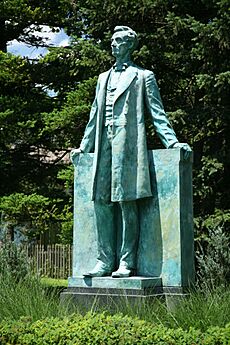
Other Parks and Nature Spots
- The Urbana Dog Park is on East Perkins Road. It's a great place to let your dog run without a leash.
- The Anita Purves Nature Center is at the north end of Crystal Lake Park. It offers programs to teach people about nature.
- "Art in the Park" is just north of the Urbana City Hall. It opened in 2012 after 22 years of planning. The park features plantings, walkways, a 12-foot tall fountain sculpture called "Falling Leaf," and a 33-foot tall light sculpture called "Spirit Tree." The "Spirit Tree" highlights Urbana's nickname as a "Tree City." The park was designed by John David Mooney, a famous artist from Champaign-Urbana.
Swimming Pools
- The Urbana Indoor Aquatic Center is a public indoor pool. It's run by the Urbana Park District and Urbana School District. It's located between Urbana High School and Urbana Middle School.
- Crystal Lake Pool is a public outdoor pool. It's on Broadway Street, across from the Anita Purves Nature Center. It was closed for a while but was rebuilt and reopened in 2013.
- Campus Recreation Center East (CRCE) has an indoor pool and a hot tub. This pool is owned by the University of Illinois Urbana–Champaign.
Sports in Urbana
Urbana is home to the sports teams of the University of Illinois Urbana-Champaign.
Illinois Fighting Illini
The University of Illinois Urbana-Champaign has many sports teams for both men and women. These teams are called the Illinois Fighting Illini.
| Team | Established | Big Ten Conference Titles | NCAA Postseason Appearances | National Titles | Venue | Opened | Capacity |
|---|---|---|---|---|---|---|---|
| Football | 1890 | 15 | 17 | 5 | Memorial Stadium | 1923 | 60,670 |
| Men's basketball | 1905 | 17 | 30 | 1 | State Farm Center | 1963 | 15,500 |
| Women's basketball | 1974 | 1 | 8 | 0 | State Farm Center | 1963 | 15,500 |
| Baseball | 1879 | 29 | 10 | 0 | Illinois Field | 1988 | 3,000 |
| Women's volleyball | 1974 | 4 | 22 | 0 | Huff Hall | 1925 | 4,050 |
| Men's gymnastics | 1898 | 24 | 44 | 10 | Huff Hall | 1925 | 4,050 |
Minor League Baseball
Urbana has also had a few minor league baseball teams over the years, often shared with Champaign.
- The Champaign-Urbana Velvets played from 1911 to 1914.
- The Champaign-Urbana Bandits played in 1994 at Illinois Field.
- The Champaign-Urbana Colts played from 1990 to 1996.
Education in Urbana
Urbana has schools for all ages, from young children to university students.
Schools for Kids and Teens
- Urbana High School: The current building for Urbana High School was built in 1914. It was designed by Joseph Royer, the same architect who designed the Urbana Free Library. The building has a Tudor style, with towers and pointed arches.
- University Laboratory High School (Uni High): This is a special public school located on the University of Illinois campus. It was founded in 1921 and is used for research by the university's College of Education.
- Urbana Middle School: This school was first known as Urbana Junior High School in 1953. It was renovated in 2003 and serves about 954 students from grades 6 to 8.
- Elementary Schools: Urbana has several elementary schools, including Leal, Dr. Martin Luther King Jr., Dr. Preston L. Williams Jr., Thomas Paine, and Yankee Ridge.
- Urbana Early Childhood School: This school, formerly Washington Early Childhood Center, is for very young children.
Colleges and Universities
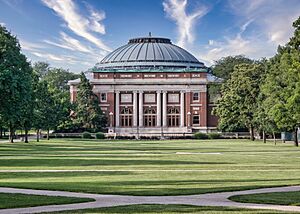
Most of the University of Illinois Urbana-Champaign campus is located in Urbana. This is a large public research university and the main school of the University of Illinois system. It is one of the largest public universities in the U.S., with over 50,000 students each year. This means Urbana has a large student population throughout the year.
Urbana Free Library
The Urbana Free Library is one of the first public libraries in Illinois. It was founded in 1874 and is in downtown Urbana. The historic building was built in 1918, and a big new addition was opened in 2005.
The library has a special collection called the Champaign County Historical Archives. This collection, started in 1956, has many records about the history and families of Champaign County. It's a great place for people to research their family history. The Archives also has a "Local History Online" database where you can find digital content like old newspapers, yearbooks, and photos.
The library is supported by public funds and also by about 600 people who are part of the Friends of the Urbana Free Library.
Media and News in Urbana
Urbana has many ways for people to get news and entertainment, including radio, TV, and newspapers.
|
FM Radio Stations
AM Radio Stations
|
Analog Television Channels
Digital Television (DTV) Channels
Newspapers
|
Transportation in Urbana
Downtown Urbana is located southwest of where two busy streets meet: U.S. 150 (University Avenue) and U.S. 45 (Vine Street-Cunningham Avenue).
Most of Urbana is south of I-74. There are three exits from I-74 that lead into Urbana: Lincoln (milepost 183), Cunningham (184), and University (185). The Lincoln exit is closest to the University of Illinois. The Cunningham exit goes to downtown Urbana. The University exit also goes to downtown Urbana and Illinois Route 130 towards Philo.
Public Transportation
Local bus service is mainly provided by the Champaign–Urbana Mass Transit District (MTD). There is also limited bus service from other operators like Champaign County Area Rural Transit System and Danville Mass Transit.
Railroads
The Norfolk Southern operates a train line that runs east to west through Urbana. This line connects businesses in eastern Urbana to the main Norfolk Southern line.
Airport
The University of Illinois Willard Airport serves Urbana and the surrounding area.
Sister Cities of Urbana
Urbana has special partnerships with three cities around the world. These are called "sister cities."
- Zomba, Malawi
- Haizhu, Guangzhou, China
- Thionville, France
Urbana received a grant from Sister Cities International to work on a project with Zomba, Malawi, and the Haizhu District in China. This project, called the Sino-African Initiative, is helping to improve how Zomba handles its trash. Urbana has been a sister city with Zomba since 2008, with Haizhu District since 2012, and with Thionville, France, since 2014. Urbana is one of only a few U.S. cities to get this special grant.
Notable People from Urbana
Images for kids
See also
 In Spanish: Urbana (Illinois) para niños
In Spanish: Urbana (Illinois) para niños





